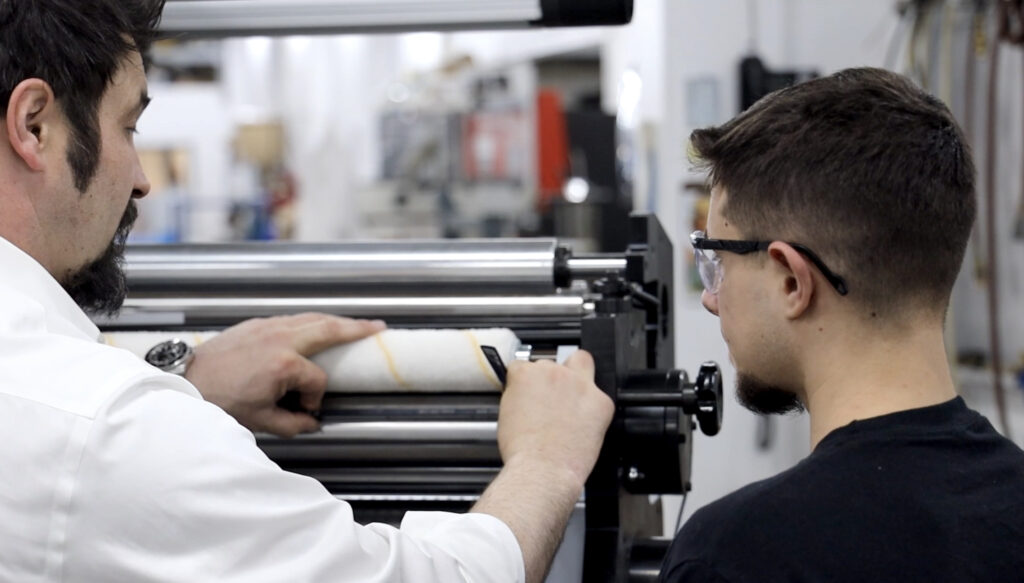Die-cutting is a vital manufacturing process that shapes materials into specific designs and is widely used in industries such as packaging, labeling, and product manufacturing. Manufacturers can produce precise and consistent cut-outs from materials like paper, cardboard, plastic, and more by using a machine and a specialized tool called a die. Two primary types of die-cutting machines are commonly employed: rotary and flatbed die-cutting machines.
Each has unique advantages and applications, and understanding these differences is essential for optimizing production efficiency, controlling costs, and achieving the desired product quality. Inline web finishing equipment can incorporate both rotary and flatbed die-cutting methods, depending on production needs.
Rotary Die-Cutting Machines
Rotary die-cutting machines operate using cylindrical dies that rotate against a continuous web of material. As the material feeds through the machine, the rotating die cuts shapes into it with precision and speed. This continuous operation makes rotary die-cutting ideal for high-volume production runs.
Advantages of Rotary Die-Cutting:
- High-Speed Production: Capable of running at high speeds, significantly reducing production time and making it perfect for large-scale manufacturing.
- Efficiency: Continuous operation minimizes downtime, integrating seamlessly with other inline processes.
- Precise Cuts on Thin Materials: Excellent for cutting thin, flexible materials like paper, film, and thin foams.
- Ideal for “Kiss Cuts”: Suitable for applications where only the top layer of material is cut, leaving the backing intact.
Limitations of Rotary Die-Cutting:
- Higher Initial Investment: The machinery and custom rotary dies are more expensive, representing a significant upfront cost.
- Material Limitations: Less effective with thicker or rigid materials.
- Tooling Costs: Custom dies can be costly, impacting budgets for short-run productions.
Flatbed Die-Cutting Machines
Flatbed die-cutting machines use a flat die and a press to cut materials placed on a stationary bed. The die presses down onto the material, cutting it into the desired shape. This method offers more flexibility in die design and material handling.
Advantages of Flatbed Die-Cutting:
- Material Versatility: Can handle a wide range of thicknesses, including thicker substrates like corrugated boards or rigid plastics.
- Complex Die Designs: Offers flexibility for intricate and custom designs, accommodating more complex die shapes.
- Precise Registration: Suited well for applications requiring meticulous alignment and precise cuts.
- Cost-Effective for Smaller Runs: Lower tooling costs make it economical for small to medium production runs or prototypes.
Limitations of Flatbed Die-Cutting:
- Slower Production Speeds: Operates at slower speeds compared to rotary machines, which can affect efficiency in large-volume productions.
- Less Ideal for High Volumes: Better suited for small to medium quantities due to longer cycle times.
- Wear and Tear: Dies may wear out faster due to the pressing action, leading to more frequent replacements.
Integrating Window Patching with Inline Finishing Equipment
Vista® In-line Window Patching Equipment
The Vista® system by Tamarack is specifically engineered to add window patching functionality for both high-volume and short-run folding carton production. This versatile equipment is ideal for efficiently applying liners, susceptor patches, and rigid windows to specialty cartons like tissue boxes, food packaging, and other products requiring visibility into the contents.
Key Features of the Vista® System:
- Quick Set-Up and Clean-Up: Designed for rapid job changes, minimizing downtime and increasing overall productivity.
- Precision Patch Registration: Ensures accurate placement of windows, which is essential for consistent, high-quality results.
- User-Friendly Touchscreen Interface: Includes an instructional guide and job parameter recall, simplifying operation and ensuring efficient production workflows.
- Direct Adhesive Application: The Vista® system applies adhesive directly to the window film, resulting in clean glue lines, reduced patch size, and increased processing speeds.
- Versatility in Patch Widths: Handles window patches up to 14 inches wide, with options for configurations up to 18 inches to meet diverse packaging needs.
With the Vista® In-line Window Patching Equipment, brands can achieve premium packaging that enhances product visibility, improves durability, and meets various production requirements efficiently.
Choosing the Right Die-Cutting Solution for Your Needs
Selecting between rotary and flatbed die-cutting machines, or integrating die-cutting capabilities with your flexo press using Tamarack’s equipment, depends on several factors:
- Production Volume: High-volume runs may benefit from rotary die-cutting or inline equipment with rotary capabilities, while low to medium volumes might be more economical with flatbed die-cutting.
- Material Types and Thickness: Thin, flexible substrates are ideal for rotary die-cutting, whereas thicker or rigid materials are better handled by flatbed die-cutting.
- Design Complexity and Precision: Intricate designs and “kiss cuts” are well-suited for rotary die-cutting, while complex die designs requiring precise registration may benefit from flatbed die-cutting.
- Budget Constraints: Consider both the initial investment and operational costs. Rotary die-cutting involves higher upfront costs but can be more cost-effective over time for large volumes.
Understanding the differences between rotary and flatbed die-cutting machines—and how they can be utilized within inline web finishing equipment—is essential for optimizing your manufacturing processes. Rotary die-cutting offers high-speed production suitable for large volumes of thin materials, while flatbed die-cutting provides versatility for thicker materials and complex designs.
With over 50 years of experience, Tamarack Products specializes in innovative web-finishing equipment designed to meet the evolving needs of the industry. Our advanced solutions can elevate your manufacturing processes, enhancing efficiency and product quality. Contact us today for a personalized consultation and take the first step toward enhancing your window patching production capabilities.





